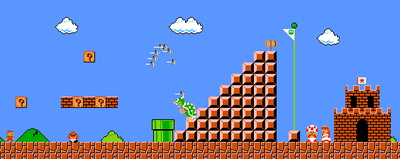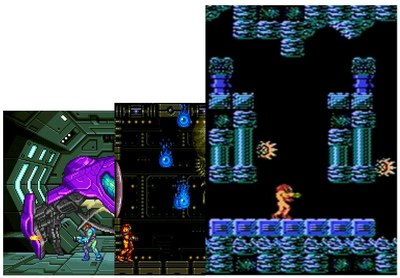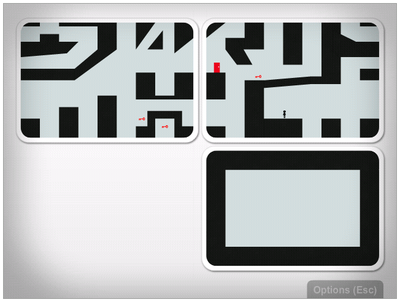Not all games use space to develop gameplay challenges, but the vast majority do. In fact, I'm having a difficult time coming up with examples that don't. Though some gamers associate the dimensions of gameplay with the graphical presentation, we know that they can be entirely separate. A while back, I covered the dimensions of gameplay in an article series called 2D + 2D = 3D. To reiterate, these articles strictly use "1D, 2D, and 3D" to describe the dynamics of gameplay. Let's not conflate the term "3D" with 3D polygonal models/renderings or 3D stereoscopic visuals. Now that most games feature polygonal graphics we don't need to use the descriptor "3D" to describe it. Actually, now that 2D, hand drawn, pixel, or cell graphics are the rarity such descriptors are more useful. The PS3, some PC titles, and especially the 3DS are pushing 3D stereoscopic gaming experiences. To differentiate, let's all use the word "stereoscopic" to refer to the new technology of eye popping visuals.
Super Mario Bros. Compressed
Most games use space. Whether you jump, shoot, or move through it, the dynamics of the space are powerful additions to game systems that are also highly intuitive. For design and/or financial reasons, many designers have found ways to get more out of the spaces they assemble. Or cram more gameplay challenges per "inch" of game space. Or display more space in less/simpler spaces. There are many ways this can be done, so I created a list to highlight a few examples.
- Advanced types of level design including folded, accordion, and pure organic inherently involve designing spaces that the player moves through multiple times experiencing different gameplay challenges. The Zelda series is perhaps the best series for excellent examples of various advanced level design types and/or compressing space. On the smallest scale, single rooms in dungeons have you moving back and forth within them to solve puzzles and progress. Within floors and whole dungeons, players unlock passage ways and navigate the dungeon in different ways. And on the largest scale, the whole game (towns, overworld, dungeons) have players criss crossing through the same spaces. Some additional ways Zelda designers compress or reuse spaces include...
- Ocarina of Time: Playing as young Link versus older Link.
- Majora's Mask: The 3 day cycle allows players to see every inch of a constantly moving world. The density of Clock Town alone is remarkable.
- Wind Waker: Hunting for all of the pieces of the Triforce near the end of the game forces players to explore areas of the sea that they might otherwise avoid when island hopping.
- Phantom Hourglass: The challenges in the Temple of the Ocean King force players to continually revisit the same challenges with new abilities and possibly new insight.
- Spirit Tracks: The overworld is used to travel to new places, battle enemies, hunt for hidden rabbits, unlock areas, and transport people and cargo.
- Minish Cap: Moving through the main town normal size and as tiny Link.
- Layered Level Design. "Design smarter not harder." Keeping all non player choices the same, layered gameplay challenges are designed in such a way as to provide significantly different challenges to the player depending on how he/she chooses to play. For a simple example, in Mega Man 10 the way the levels and the robot masters (bosses) are designed, using the "right" power, the M.Buster only, or playing with Mega Man/Bass/Proto Man changes the skill required to master the challenges. The idea is, if you can design 1 level to create unique experiences for 5 major ways players can play, you've essentially compressed 5 levels into one.
- New Missions. Perfect Dark Carrington Institute- Defense: From the beginning of the game, all missions, options, and menus are accessed from inside your home base. Before going into any game mode, players are free to explore their base, talk to allies, practice firing every weapon, test every spy gadget, and even practice riding a hover skooter. This allows players to become familiar with gameplay mechanics outside of the stress of missions. Just 15 missions into the game, the bad guys infiltrate and take over your home base. What was once a fictional and functional training facility, becomes a hostage situation. This design reuses the institute space by dropping in new gameplay objectives.
From left to right, Fusion, Super Metroid, and Metroid (NES)
- New Mechanics. Metroid Fusion. Compared to Metroid NES, the GBA limits the amount of displayable space available relative to Samus' size. With a smaller view, challenges in Metroid Fusion were redesigned to compensate. One major way this was done is by giving Samus a few new mechanics that can be executed well in small spaces. Her new ledge grab and pull up allows level designers to create ledges that you only have to barely reach instead of clearing over the top. From the ledge, players can also curl into a ball to squeeze into small spaces. Factor in horizontal ladders, a wall kick, small morph ball form, and diagonal shooting and the player has a lot of options for moving and shooting thus compressing the space.
- Screen Wrapping. From the classic Mario Bros. battle to newer games like Twin Shot, additional paths and/or momentum can be created as you move through the level by using the screen wrapping feature. With this design, players aren't stopped by certain stage boundaries. Instead they can use them to keep their direction and speed. In this way, the level design allows players to maintain motion in ways that would normally be possible in a much larger level. Thus the space is compressed.
- LittleBigPlanet lanes. The 3 punctuated lanes of 2D space in LBP give you (yes you) the option to create up to three 2D "levels" all stacked on top of the same space. The lanes give designers the option to make very dense levels thus compressing the space. For an interesting example of a compressed LBP platforming "playground," check out this level I made.
- Jumpman. This indie game is like LittleBigPlanet, but with more layers and more limited ways to travel back and forth between them. In addition to the layering of platforms, players can rotate the game world. These options add even more ways for the level designer to compress different platforming challenges in the same space.
- Continuity. In this puzzle game, players slide cells containing different platform arrangements around in a grid. If the sides of any 2 cells perfectly line up with each other, you can navigate your platforming avatar across the cells. With these mechanics, a single cell can be arranged to create multiple platforming paths and/or challenges. Check out the level above. With just 2 cell,s players can travel in all four directions when lined up correctly. That's like 5 cells of space compressed into just 2.
- Compressing the presentation. Mighty Flip Champs! In this puzzle game, 3D environments are punctuated into a series of 2D side scrolling pages. With the FLIP mechanic, players can transfer from one page to the next cycling endlessly. Because you can only move through the pages in one cyclic direction, the visual presentation of a complex 3D space is compressed to 2 2D screens at a time.
- Miegakure. This developing puzzle game presents a complex 4D space layered into a 3D space. Functionally, from what I understand, the core mechanics/dynamics of this game are almost the same as switching through layers in Jupman or page FLIPping in Mighty Flip Champs! Basically, there are multiple layers existing within the same space that you can move between to solve simple environmental puzzles. If you try to wrap your head around this game by thinking in terms of 4D space or by watching this very informative video, you might think a game like this has never been done before.



 Richard Terrell (KirbyKid)
Richard Terrell (KirbyKid)